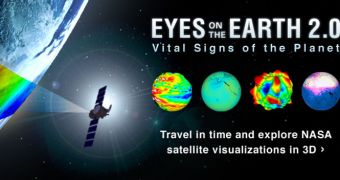Boasting a sleek and simplified interface, as well as a new version of the popular “Eyes on the Earth” interactive virtual reality visualization, the NASA Global Climate Change website looks better than ever. The page can be accessed here, or directly here.
The page has already won the Webby Award, a feat that NASA is very proud of. This is partially why the agency decided to improve the product even further, enabling users at home to gain access to data and images produced by the vast constellation of spacecraft the agency operates in Earth's orbit.
Some of the newest features include the addition of event timelines, an image gallery and more up-to-date data on global sea level height and surface temperatures. Some of the data previously on the page were obsolete, incomplete, or slightly inaccurate.
Additionally, several NASA centers, including the Earth Observing System Project Science Office, the Jet Propulsion Laboratory, and the Earth Observatory website, came together to create a new, Image of the Day feature.
“The Image of the Day has long been one of the most popular features of the NASA Earth Observatory. Now we're enhancing the experience for users by allowing them to see these spectacular images in context in a virtual 3D environment,” says Kevin Ward.
The expert hods an appointment as the technical/development lead for the Earth Observatory, and is based at the NASA Goddard Space Flight Center (GSFC), in Greenbelt, Maryland.
“Eyes on the Earth 2.0 gives cyber explorers daily glimpses of our dynamic planet from space,” adds the JPL manager for public engagement formulation and strategic alliances, Michael Greene.
“On any given day, visitors might see anything from a wall of gray smoke more than 10 miles long from a major wildfire, a phytoplankton bloom exploding in brilliant shades of blue and green off the coast of Norway, or a typhoon half as wide as North America churning across the South China Sea,” he adds.
NASA's Global Climate Change website is devoted to improving the public's understanding of Earth's changing climate, providing easy-to-understand information about the causes and effects of climate change and how NASA studies it.

 14 DAY TRIAL //
14 DAY TRIAL //